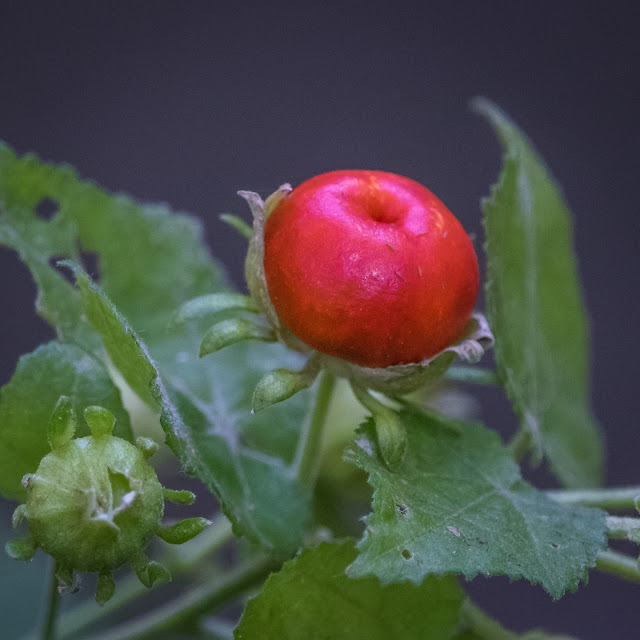 |
| Turk's Cap is a wonderful native plant for a summer garden. |
In the heat of a central Texas summer, few plants are as versatile as Drummond’s Turk’s Cap (Malvaviscus arboreus var. drummondii). Also known simply as Turk’s Cap, Texas Mallow, Sleeping Hibiscus, or Manzanilla, this hardy native plant provides color, shade, and food for a variety of species.
For humans, Turk’s Cap is a gardener’s delight. It thrives in woodland edges and limestone slopes in partially shaded sites, and does especially well under oaks or junipers. It is drought-hardy, requiring little water once established, and blooms profusely from May to November. It is a deciduous shrub, to 4 feet, spreading via roots but easily controlled. Its leaves are alternate, simple, and roughly heart-shaped, with 3 to 5 shallow lobes.
 |
| A top down view of the five whorled petals of a Turk's Cap flower. |
 |
| Turk's Cap produces small, edible, apple-like fruits. |
The most common name of Turk’s Cap comes from its bright red flowers, comprised of 5 overlapping whorled petals, up to 2 inches long including the protruding stamen, and resembling a Turkish turban. They also look like small, closed versions of a hibiscus flower, hence the name Sleeping Hibiscus. These flowers develop into red, 1 inch wide, 5-lobed, apple-like fruits, giving the plant yet another common name of Manzanilla, meaning “little apple.” These fruits are edible for humans and wildlife and taste like watermelon.
 |
| An adult Turk's-cap White-Skipper butterfly. |
Turk’s Cap is a host plant for several butterflies and moths, meaning the females lay their eggs on this species so their caterpillars can feed on it. Turk’s-cap White-Skipper (more common in south Texas), Io Moth, Yellow Scallop Moth, Straight-lined Mallow Moth, Cotton Tipworm Moth, and Window-winged Moth. Caterpillars eat different parts of the plant, from the tender young leaves to the flowers and fruits. Young caterpillars hide in crevices on the host plant, while older ones live in shelters made of leaves.
 |
| An Orange-barred Sulphur inserts its long proboscis into the flower. |
 |
| Hummingbird beaks are the perfect shape to reach the flower's nectar. |
Turk’s Cap also does double duty as a nectar plant, for those animals that can find a way to access its sweet nectar. Larger butterflies such as the Orange-barred Sulphur can reach into the flower with a long tongue or proboscis, hummingbirds such as the Black-chinned Hummingbird can uses its long and slender, straw-like beak, and some bumblebees and carpenter bees have strong mouthparts that can chew a hole or slit at the base of the flower where the nectar resides.
 |
| Bumblebees can access the nectar by cutting through the flower's base. |
 |
| And some bumblebees just dive in head first! |
The leaves of Turk’s Cap have been used in the past as an emollient to treat inflammation, aid digestion, soften skin, and soothe itching. The flowers can be used to make a hibiscus tea, and the fruits can be made into a delightful syrup or jelly. Now that you know all about the wonderful aspects of this masterful mallow, consider planting it in your garden this coming fall!